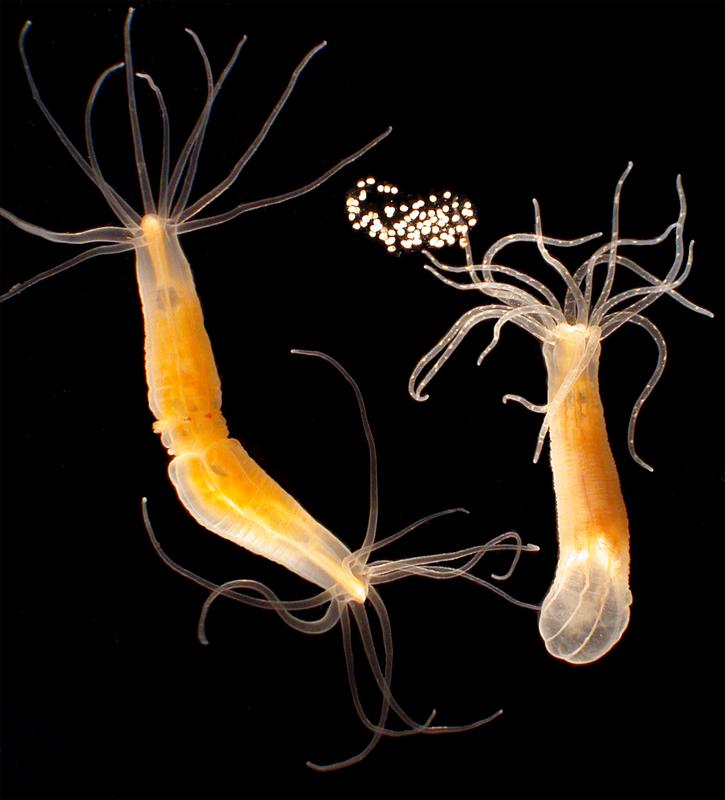Rapid adaptation to a changing environment

The sea anemone Nematostella vectensis grows to a length of 5-8 centimetres and is commonly found off North Atlantic coasts. Photo: Dr. Adam Reitzel
Kiel-based biologist Dr. Sebastian Fraune from Kiel University's Cell and Developmental Biology working group has recently succeeded in gaining significant individual funding: out of around 200 applications, his new research project, together with six other projects, claimed this year's funding awarded by the international “Human Frontier Science Program” (HFSP).
Together with a US-American and an Australian colleague, Fraune will now be working on the question of how living things are able to quickly adapt to changed environmental conditions influenced by climate change. Over the next three years, the equivalent of 900,000 euros of HFSP funds will now be available to the Kiel-based biologist as well as Dr. Adam Reitzel from the University of North Carolina at Charlotte and Dr. Sylvain Foret from the Australian National University in Canberra for this research work.
Living things adapt to their environment from generation to generation by gradually changing and reconfiguring their genetic information – this is how the traditional theory of evolution explains the ability of all living things to change. As a result of global warming, however, many species are displaying an extremely quick ability to adapt to changing living conditions.
Clearly, factors that are to date unknown must be responsible for this. According to Fraune, Reitzel and Foret, epigenetics, i.e. heredity controlled by changes in chromosomes, and bacterial colonisation of an organism could be the driving forces behind this accelerated evolution. As unlike the composition of genes, these two factors can react quickly to environmental change.
The researchers plan to study the influence of epigenetics and bacterial colonisation on the sea anemone species Nematostella vectensis. They aim to find out how these creatures can adapt themselves specifically to changes in water temperature – and how they pass these adaptations on to their progeny. The first findings suggest that the anemones do this by changing their bacterial colonisation. “The already noticeable effects of climate change show that the traditional model of evolution is not adequate to explain environmental adaptations – it is simply too slow. We want to find out whether the changes in the bacterial composition of an organism and the influence of epigenetics can provide the missing explanations”, says Fraune.
Using the adaptation to temperature of sea anemones living in environments strongly affected by climate change as an example, the aim of the research project is to determine whether non-genetic factors may be responsible for the ability of living things to quickly adapt to changing environmental conditions. The answer to these questions could provide fundamental findings for a new research field: scientists around the world have begun to redefine life as a functional unit of different living things beyond the boundaries of biological species.
They call this type of unit a metaorganism. For a few weeks now, Kiel University has had its own new Collaborative Research Centre (CRC) 1182 “Origin and Function of Metaorganisms”. Fraune is involved in this with two additional projects. The new CRC deals with all aspects of the issue of the origin and effects of interactions between living things, micro-organisms and environment defined as metaorganisms. Fraune's HFSP project could provide an important contribution to this research by highlighting the role of interactions between organism and bacteria in the context of environment adaptation.
About the Human Frontier Science Program
The Human Frontier Science Program (HFSP) is an international research support program in life sciences. Key elements are, in particular, innovative, cutting edge research approaches that are expected to extend the borders of research fields within the life sciences. HFSP funding is also aimed at establishing international partnerships, supporting young scientists and strengthening interdisciplinary cooperation. The HFSP program is one of the most important and financially strongest international sponsors of research into life sciences, especially in its support of young scientists. It is sponsored by the European Union (EU) and ten other non-EU states.
Photos/material is available for download:
http://www.uni-kiel.de/download/pm/2016/2016-129-1.jpg
The sea anemone Nematostella vectensis grows to a length of 5-8 centimetres and is commonly found off North Atlantic coasts.
Photo: Dr. Adam Reitzel
http://www.uni-kiel.de/download/pm/2016/2016-129-2.jpg
The sea anemones are easily bred in the laboratory, and thanks to their simple structure they often serve as model organisms in biology.
Photo: Christian Urban, Kiel University
Contact:
Dr. Sebastian Fraune
Zoological Institute, Kiel University
Tel.: +49 (0)431-880-4149
E-Mail: sfraune@zoologie.uni-kiel.de
More information:
Dr. Sebastian Fraune's website:
http://www.bosch.zoologie.uni-kiel.de/?page_id=757
“Human Frontier Science Program”:
http://www.hfsp.org/
Collaborative Research Centre (CRC) 1182 “Origin and Function of Metaorganisms”:
http://www.metaorganism-research.com/
Kiel University
Press, Communication and Marketing, Dr. Boris Pawlowski
Address: D-24098 Kiel, phone: +49 (0431) 880-2104, fax: +49 (0431) 880-1355
E-Mail: ► presse@uv.uni-kiel.de, Internet: ► www.uni-kiel.de
Twitter: ► www.twitter.com/kieluni, Facebook: ► www.facebook.com/kieluni
Text / Redaktion: Christian Urban
Media Contact
All latest news from the category: Life Sciences and Chemistry
Articles and reports from the Life Sciences and chemistry area deal with applied and basic research into modern biology, chemistry and human medicine.
Valuable information can be found on a range of life sciences fields including bacteriology, biochemistry, bionics, bioinformatics, biophysics, biotechnology, genetics, geobotany, human biology, marine biology, microbiology, molecular biology, cellular biology, zoology, bioinorganic chemistry, microchemistry and environmental chemistry.
Newest articles

“Nanostitches” enable lighter and tougher composite materials
In research that may lead to next-generation airplanes and spacecraft, MIT engineers used carbon nanotubes to prevent cracking in multilayered composites. To save on fuel and reduce aircraft emissions, engineers…

Trash to treasure
Researchers turn metal waste into catalyst for hydrogen. Scientists have found a way to transform metal waste into a highly efficient catalyst to make hydrogen from water, a discovery that…

Real-time detection of infectious disease viruses
… by searching for molecular fingerprinting. A research team consisting of Professor Kyoung-Duck Park and Taeyoung Moon and Huitae Joo, PhD candidates, from the Department of Physics at Pohang University…





















